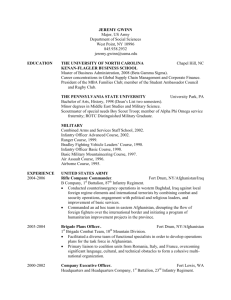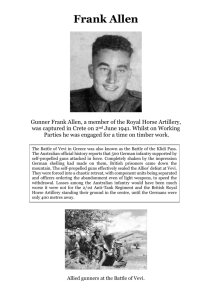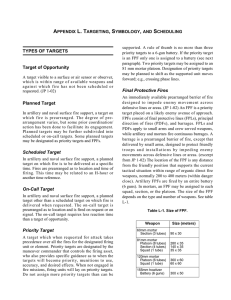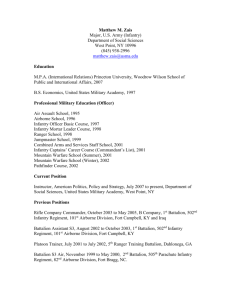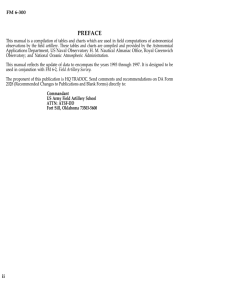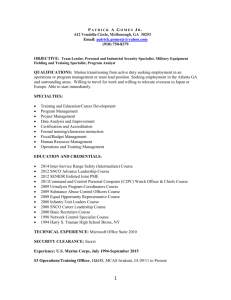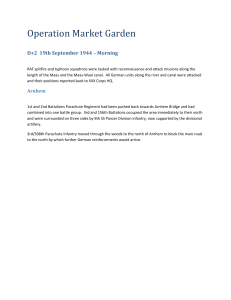A L. T , S ,
advertisement
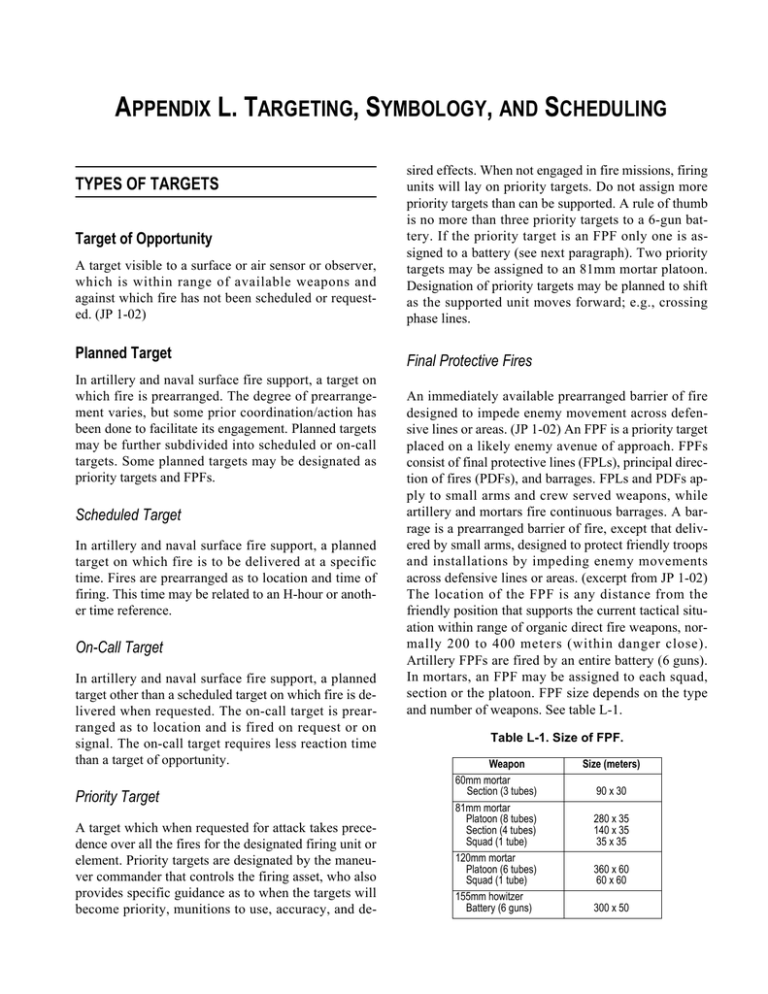
APPENDIX L. TARGETING, SYMBOLOGY, AND SCHEDULING TYPES OF TARGETS Target of Opportunity A target visible to a surface or air sensor or observer, which is within range of available weapons and against which fire has not been scheduled or requested. (JP 1-02) Planned Target In artillery and naval surface fire support, a target on which fire is prearranged. The degree of prearrangement varies, but some prior coordination/action has been done to facilitate its engagement. Planned targets may be further subdivided into scheduled or on-call targets. Some planned targets may be designated as priority targets and FPFs. Scheduled Target In artillery and naval surface fire support, a planned target on which fire is to be delivered at a specific time. Fires are prearranged as to location and time of firing. This time may be related to an H-hour or another time reference. On-Call Target In artillery and naval surface fire support, a planned target other than a scheduled target on which fire is delivered when requested. The on-call target is prearranged as to location and is fired on request or on signal. The on-call target requires less reaction time than a target of opportunity. Priority Target A target which when requested for attack takes precedence over all the fires for the designated firing unit or element. Priority targets are designated by the maneuver commander that controls the firing asset, who also provides specific guidance as to when the targets will become priority, munitions to use, accuracy, and de- sired effects. When not engaged in fire missions, firing units will lay on priority targets. Do not assign more priority targets than can be supported. A rule of thumb is no more than three priority targets to a 6-gun battery. If the priority target is an FPF only one is assigned to a battery (see next paragraph). Two priority targets may be assigned to an 81mm mortar platoon. Designation of priority targets may be planned to shift as the supported unit moves forward; e.g., crossing phase lines. Final Protective Fires An immediately available prearranged barrier of fire designed to impede enemy movement across defensive lines or areas. (JP 1-02) An FPF is a priority target placed on a likely enemy avenue of approach. FPFs consist of final protective lines (FPLs), principal direction of fires (PDFs), and barrages. FPLs and PDFs apply to small arms and crew served weapons, while artillery and mortars fire continuous barrages. A barrage is a prearranged barrier of fire, except that delivered by small arms, designed to protect friendly troops and installations by impeding enemy movements across defensive lines or areas. (excerpt from JP 1-02) The location of the FPF is any distance from the friendly position that supports the current tactical situation within range of organic direct fire weapons, normally 200 to 400 meters (within danger close). Artillery FPFs are fired by an entire battery (6 guns). In mortars, an FPF may be assigned to each squad, section or the platoon. FPF size depends on the type and number of weapons. See table L-1. Table L-1. Size of FPF. Weapon 60mm mortar Section (3 tubes) 81mm mortar Platoon (8 tubes) Section (4 tubes) Squad (1 tube) 120mm mortar Platoon (6 tubes) Squad (1 tube) 155mm howitzer Battery (6 guns) Size (meters) 90 x 30 280 x 35 140 x 35 35 x 35 360 x 60 60 x 60 300 x 50 L-2 ________________________________________________________________________________________________ Target Numbering System To designate targets for fire support operations, the Marine Corps adheres to the provisions of A-Arty P-1 and QSTAG 221. Provisions to the target numbering system are specified in the fire support plan. The Target Number The target number consists of six characters, comprising two letters and four numerals; e.g., AB1234. The two letter group may be used to indicate the originator of the target number and/or the level controlling the target data. First Letter Second Letter The second letter designates units within the MAGTF. See table L-2. Table L-2. Letter Assignments—Marine Units. I MARINE EXPEDITIONARY FORCE 1ST MARINE DIVISION l Belgium/Luxembourg, B. l Canada, C, Z. l Denmark, D. l France, F. l Greece, E. l Germany, G. l Italy, I. l Netherlands, H. l Norway, N. l Portugal, P. l A B 1st Marine Infantry Regiment C 5th Marine Infantry Regiment D 7th Marine Infantry Regiment E 11th Marine Artillery Regiment F II MARINE EXPEDITIONARY FORCE 2D MARINE DIVISION The CINC, joint, or the common commander to Army and Marine forces assigns the first letter of the target number to Army Corps and the MEF/MAGTF. The national identifying letters for NATO and ABCA armies are American, British, Canadian, and Australian. Nations with corresponding first letters follow: MCWP 3-16 G H 2d Marine Infantry Regiment I 6th Marine Infantry Regiment J 8th Marine Infantry Regiment K 10th Marine Artillery Regiment L III MARINE EXPEDITIONARY FORCE 3D MARINE DIVISION M N 3d Marine Infantry Regiment O 4th Marine Infantry Regiment P 12th Marine Artillery Regiment Q MARINE FORCES RESERVE R 4TH MARINE DIVISION S 23d Marine Infantry Regiment T Spain, S. 24th Marine Infantry Regiment U l Turkey I,O,T. 25th Marine Infantry Regiment V l United Kingdom, J,U, X. 14th Marine Artillery Regiment W l United States, A, K,Y,W. l Others, V. UNASSIGNED X,Y, Z Fire Support Coordination in the Ground Combat Element Numbers ______________________________________________ Table L-5. Number Assignments—Marine Infantry Regiments. Numbers further designate units. See table L-3. Table L-3. Number Assignments—MEF Command Elements. 0000-1999 Infantry Regiment FSCC 2000-2999 Lowest Numbered Infantry Battalion 3000-3999 Second Lowest Numbered Infantry Battalion 0000-0999 MEF FFCC 4000-4999 Third Lowest Numbered Infantry Battalion 1000-1999 MEB Command Element 5000-5999 Attached Battalion 2000-2999 Lowest Numbered MEU Command Element 6000-6999 Attached Battalion 3000-3999 Second Lowest Numbered MEU Command Element 7000-9999 Unassigned 4000-4999 Third Lowest Numbered MEU Command Elements 5000-5999 MAW 6000-6999 FSSG/RAOC 7000-7999 Force Reconnaissance Company 0000-0999 Regimental Fire Direction Center 8000-8999 Unassigned 1000-1999 Lowest Numbered Artillery Battalion 9000-9999 Weapons of Mass Destruction 2000-2999 Second Lowest Numbered Artillery Battalion 3000-3999 Third Lowest Numbered Artillery Battalion 4000-4999 Attached Artillery Battalion 5000-5999 Attached Artillery Battalion 6000-6999 Counterfire 7000-9999 Unassigned Table L-6. Number Assignments—Marine Artillery Regiments. I MEF will assign MEB and MEU(SOC) numbers to 1st MEB, 11th, 13th, and 15th MEU’s. II MEF will assign MEB and MEU(SOC) numbers to 2d MEB, 22nd, 24th, and 26th MEUs. III MEF will assign MEB and MEU(SOC) numbers to 3d MEB, 31st MEU(SOC). Units assigned to the MEB and MEU(SOC) use their block of numbers assigned under the division to which they belong. See tables L-4 through L-7. Table L-4. Number Assignments—Marine Divisions. 0000-0999 Division FSCC 1000-1999 Tank Battalion 2000-2999 LAR Battalion 3000-3999 Reconnaissance Battalion 4000-9999 Unassigned Table L-7. Number Assignments—Marine Infantry Battalions. 0000-0199 Infantry Battalion FSCC 0200-0299 Lowest Lettered Infantry Company 0300-0399 Second Lowest Lettered Infantry Company 0400-0499 Third Lowest Lettered Infantry Company 0500-0599 Weapons Company 0600-0699 Scout Sniper Platoon 0700-0799 81mm MTR Platoon 0800-0899 Attachment 0900-0999 Attachment L-3 L-4 ________________________________________________________________________________________________ Each Infantry battalion block of numbers assigned will be different based on whether they are the lowest numbered battalion, second lowest numbered battalion, or the third lowest numbered battalion. Forward observers and naval gunfire spotters will use target numbers assigned to them from the Infantry company they are supporting. Table L-8 provides number blocks for artillery battalion FDCs. Table L-9 provides examples as discussed in tables L-2 through L-8. Table L-8. Number Assignments—Marine Artillery Battalions. 0000-0199 Artillery Battalion FDC 0200-0299 Lowest Lettered Artillery Battery 0300-0399 Second Lowest Lettered Artillery Battery 0400-0499 Third Lowest Lettered Artillery Battery 0500-0599 Attachment 0600-0699 Attachment MCWP 3-16 Target Symbols Standard symbols are used to prepare maps, charts, and overlays to identify targets by type. Point Target A target of such small dimension that it requires the accurate placement of ordnance in order to neutralize or destroy it. (JP 1-02). It is generally a target that is 200 meters or less in length and width. The symbol shows the proper placement of the target number. See figure L-1. Figure L-1. Point Target. Table L-9. Examples of Marine Corps Target Numbering System. MEF I MEF FFCC AA 0000-0999 11th MEU FFCC AA 2000-2999 3D MEB FFCC AM 1000-1999 ARTILLERY REGIMENT B BTRY 1/10 AL 1300-1399 F BTRY 2/11 AF 2300-2399 A BTRY 1/12 AQ 1100-1199 DIVISION 3D MARDIV FSCC AN 0000-0999 10th MARINES FDC AL 0000-0999 1ST TANK BATTALION AB 1000-1999 INFANTRY BATTALION B CO. 1/6 FO AJ 1300-1399 SCOUT SNIPER 2/3 AO 3600-3699 *BLT 3/1 (CHOPPED TO 11TH MEU) AC 4000-4999 SPOT TM C/1/7 AE 2400-2499 INFANTRY REGIMENT 8TH MARINES FSCC AK 0001-0999 2/3 FSCC AO 3000-3199 1/7 FSCC AE 2000-2199 *BLT 3/1 Supports 11th MEU. BLT 3/1 will use 1st Marines target numbers. Fire Support Coordination in the Ground Combat Element ______________________________________________ L-5 Linear Target Final Protective Fire A target that is more than 200 meters but less than 600 meters long. Targets longer than 600 meters may be subdivided into multiple targets for attack with indirect fire. A linear target is designated on the target list or list of targets by two grids or a center grid, length, and attitude. Automated systems define linear targets by a ratio of at least 5:1, length to width, respectively. See figure L-2. The FPF is normally drawn as a linear target. For a mortar, FPFs assigned to individual weapons may be depicted as a circular target. The symbol used includes the target number, the designation of FPF, and the system/unit to deliver the fires. The FPF symbol is drawn to scale. See figure L-5. Figure L-5. FPF. Figure L-2. Linear Target. Rectangular Target A target wider and longer than 200 meters. It is designated on the target list or list of targets by a center grid, length, width, and attitude. Automated systems define rectangular targets by a ratio of less than 5:1, length to width, respectively. See figure L-3. Target Reference Point (TRP) Maneuver elements use an easily identifiable TRP to orient direct fire weapons systems. TRPs should only be identified in terms of the direct fire system, not the target numbering system. The symbol is the same as that for a standard target with a TRP letter. Only TRPs used as triggers for fire support events are integrated into the scheme of fires. Essential TRPs are included on internal lists of targets and identified in the remarks section as TRP. This provides observers direct interface with direct fire systems. See figure L-6. Figure L-3. Rectangular Target. Circular Target A target that is circular in nature or is vague as to its exact shape. It is designated by a center grid and a radius on the target list or list of targets. See figure L-4. Figure L-6. TRP. AFATDS Geometries Figure L-4. Circular Target. Figure L-7 on page L-6 shows how AFATDS displays target symbols. See MCRP 3-16.2A for specific instructions for AFATDS. L-6 ________________________________________________________________________________________________ Geometry Situation: Friendly (F) Enemy (E) Border Color: Friendly (F) Enemy (E) Target Area of Interest F F-Blue Current Symbol TAI Name Point Target F Rectangular Target F Circular Target F Linear Target F F Planned Symbol TAI Name F-Black number altitude description number altitude description number number Number Number F-Black F-Black F-Black number Target Reference Point MCWP 3-16 number F-Black number number Figure L-7. AFATDS Targeting Geometries. Target List Worksheet The target list worksheet is a document that facilitates fire planning by the FSC (see fig. L-8) for a sample. It is a preliminary listing of all targets and their descriptions from which the FSC can select and plan. The U.S. Army publishes the worksheet as DA Form 4655R. The information contained on target list worksheets can be maintained and transmitted digitally as well. Instructions to prepare the DA Form 4655-R follow. ______________________________________________ Fire Support Coordination in the Ground Combat Element L-7 Heading Altitude On the left hand side, place the unit that filled out the target list worksheet, the OPORD, and the DTG. On the right side, fill in the number of target list pages. Place the DATUM that the targets were described from. This may not always be WGS-84. Show the altitude of the target in meters, unless otherwise specified. Attitude Line Number Enter the attitude of linear and rectangular targets in grid azimuths. This is an administrative control measure for internal use. Assign each target a line number. Size (Length and Width) Target Number Assign each target a target number from the block of numbers given to the planning source. Source and/or Accuracy Description Enter a concise target description that is adequate for a decision on how the target should be attacked. Location Enter grid coordinates for point, rectangular, and circular targets. For linear targets, enter coordinates of the center point. If writing in the endpoints use two lines. 1st Mar, 1st MARDIV The information in this column aids in determining how to attack the target. When known, enter the source and accuracy of the target data. Remarks Enter any special considerations for attack of the target such as requested munitions or method of attack. DATUM: WGS-84 Target List Worksheet OPORD _________ 070620ZFEB00 LINE NO Enter no dimensions for a point target, one dimension (length) for a linear target, two dimensions (length and width) for a rectangular target, or the radius of a circular target (width). For use of this form see FM 6-20-40; Proponent agency is TRADOC SHEET____ of ____ TARGET NO DESCRIPTION LOCATION ALTITUDE ATTITUDE a b c d e 1 AC0001 120 mm Mortar Plt 499377 2 AC0002 Rifle Company 516325 3 AC0003 Rifle Platoon 554296 4 AC0004 OP 570281 5 AC0005 MG Position 566260 6 AC0006 Trail Intersection 572247 SIZE LENGTH f WIDTH g SOURCE/ ACCURACY REMARKS h i DPICM VT 50%, WP 50% CP 11 Figure L-8. Sample Target List Worksheet. LINE NO DESCRIPTION b TARGET NO a c LOCATION e ATTITUDE f LENGTH SIZE g WIDTH h SOURCE/ ACCURACY Figure L-9. Blank Target List Worksheet. d ALTITUDE For use of this form see FM 6-20-40; Proponent agency is TRADOC Target List Worksheet i REMARKS SHEET____ of ____ DATUM: WGS-84 L-8 ________________________________________________________________________________________________ MCWP 3-16 Fire Support Coordination in the Ground Combat Element Work Columns ______________________________________________ L-9 once. These target lists include active, inactive, oncall, suspect, planned, and any named target lists. These columns are used to indicate targets that are to be included in a particular fire support schedule. Enter one diagonal line (/) under the appropriate column to show the target is to be included in a particular schedule. When the target has been scheduled, enter an opposing diagonal line, forming an X to show the action is complete. Figure L-9 is a blank target list worksheet. Automated Target List Automated systems, such as AFATDS, will have the means to store, execute, and refine lists of targets. See figure L-10. Because of their storage capability, these automated systems can maintain several target lists at TYPES OF PLANNED FIRES Group of Targets A group is two or more targets on which fire is desired simultaneously. A group of targets is designated by a letter/number/letter combination. It is graphically displayed by circling the targets. The first letter is that of the country (as assigned by the MAGTF or senior headquarters). The number is assigned sequentially as it is used. The last letter is the letter assigned to the unit planning the group. When planning groups of targets, consideration must be Figure L-10. Example of an AFATDS. L-10 _______________________________________________________________________________________________ MCWP 3-16 given to the number of firing units (artillery units [battery/battalion], mortar platoon, or NSFS) available. For NSFS, multiple targets may be assigned to a ship if the ship is equipped with multiple gun mounts and a surface fires control system which can accommodate the missions; e.g., MK-86 GFCS. Targets included in a group may be engaged individually if required. Groups are executed at a predetermined time, on-call, or when a certain event occurs. Figure L-11 illustrates the graphic designation of a group. Program of Targets A program is the predetermined sequential attack of targets of a similar nature. It may be executed on-call, at a specific time, or when a particular event occurs. Targets are designated by their nature and based upon the commander’s guidance. For example, in a counterfire program, all the targets are artillery system related OPs, artillery batteries, mortar platoon, CPs. Programs may be planned for various purposes; e.g., counterfire, SEAD, counter-OP, countermechanized. Programs are not graphically displayed. Preparation Fire Figure L-11. Group of Targets. Series of Targets In artillery and NSFS, a number of targets and/or groups(s) of targets planned to support a maneuver phase. The targets in a series are fired in accordance with a time sequence. A series is given a nickname by the unit planning the series. A series may include mortars and CAS also. A series may be fired at a predetermined time, on-call, or when a certain event occurs. See figure L-12 for a graphic illustration of a series. Figure L-12. Series of Targets. Fire delivered on a target preparatory to an assault. (JP 1-02). It is an intense volume of fire delivered in accordance with a time schedule. The fires normally commence prior to H-hour and may extend beyond it. They may start at a prescribed time or be held on-call. The duration of the preparation is influenced by factors such as the fire support needs of the entire force, numbers of targets, and firing assets and ammunition available. Preparation fires may not always be warranted. Factors influencing the commander’s decision of whether or not to plan/execute a prep include availability of accurate targets, fire support and ammunition available, whether the benefits produced by the prep will offset the loss of surprise, and the time available. The timing and the execution of the prep should take into account the enemies ability to recover. The prep may include all supporting arms. Critical targets may be identified for damage assessment. Observation on these targets can be achieved by various sources; e.g., reconnaissance teams, weapons locating radars of the artillery regiment. If desired effects have not been achieved, reattack may be required. Generally, adjustments cannot be made during the preparation. Therefore, observers must refine target locations for all scheduled fires, and firing units must emphasize proper gunnery procedures to promote accurate fires. Procedures must be established to engage priority targets during the prep if necessary. These targets may be identified as on-call targets on the schedule. This may require a firing unit to be temporarily removed from the prep, engage the priority target, and then resume firing the prep. Firing units will notify the Fire Support Coordination in the Ground Combat Element FSCC of any assigned targets that were not engaged or that were only partially engaged. Counterpreparation Fire Intensive prearranged fire delivered when the imminence of the enemy attack is discovered. It is designed to: break up enemy formations; disorganize the enemy’s systems of command, communications, and observation; decrease the effectiveness of artillery preparation; and impair the enemy’s offensive spirit. (JP 1-02). Barrage Fire Fire which is designed to fill a volume of space or area rather than aimed specifically at a given target. (JP 1-02) Barrage fire is a prearranged technique for the engagement of targets of opportunity or planned targets. The target area is configured to effect the desired results. The target area may be defined to restrict the enemy’s movement; e.g., avenue of approach or to isolate an enemy unit (prevent reinforcement or withdrawal). The volume and duration of fire is based on its intended effect and tactical situation. The fires may be delivered in a prearranged target configuration; e.g., a horseshoe pattern around the friendly position or in a random, sweeping manner throughout the target area. Program Names in Automated Systems AFATDS names programs and schedules of fire in accordance with the above paragraphs. However due to its fixed message formats, IFSAS can only name geometries and fireplans using six characters. Refer to FMFM 6-18-1/MCWP 3-16.2, MCFSS, appendix C, for the naming convention required by IFSAS. Below are some IFSAS naming convention examples: SE21A6 2d Series established by 1st Bn, 6th Mar CF1T10 1st Counterfire Program established by 10th Mar TPC SA12MD 1st SEAD Program established by 2d MARDIV _____________________________________________ L-11 SCHEDULING OF FIRE The procedures provided in this paragraph are used in scheduling fires. The quick fire support plan form or the scheduling worksheet form may be used. General Procedures for All Schedules Worksheet A separate worksheet is used for each schedule planned to support an operation. Groups may be recorded on the same worksheet. Heading of Worksheet The worksheet heading includes type/name of the schedule and the supported unit for which it is prepared. Timing Block To the right of the block labeled firing unit is the timing block. The fire planner writes the appropriate minute each hash mark is to indicate in the schedule; e.g., -6 through +4. Firing Unit Line Number Each firing unit is assigned its own line number in the schedule. Record the unit; e.g., 2/10, the caliber of weapon; e.g., 155, the type of weapon; e.g., T for towed or SP for self-propelled, and the firing unit; e.g., D. Dots and Lines For each target to be engaged by a single volley, indicate the TOT by a dot on the worksheet at the appropriate time. For each target to be fired with more than one volley, indicate the duration of the fires by drawing a horizontal line between the appropriate time lines. The first rounds will impact at the time corresponding with the beginning of the line, and the last rounds will impact at the time corresponding with the end of the line. The number of rounds fired depends on the rate of fire for scheduling. Figure L-13 on page L-12 illustrates the use of dots and lines on the worksheet. L-12 _______________________________________________________________________________________________ MCWP 3-16 Fire Support Coordination in the Ground Combat Element _____________________________________________ Damage Criteria Instructions for Specific Schedules See chapter 3, section II. Preparation Fires Target Number and Ammunition The target number is shown above the line/dot with the amount of ammunition to be fired below the line/ dot. If the munition is other than standard, this is indicated by use of a subscript with specific instructions recorded in the remarks column. Remarks should be recorded one line beneath the last scheduled line. Shift Times and Rates of Fire for Scheduling Shift time is the length of time needed for the firing unit to cease firing on one target and commence firing on its next scheduled target. When scheduling fires, shift times must be allowed. Gaps (2 or more shift times) should be avoided, except in a series of targets. The number of rounds fired by a weapon in a specific duration (designated by length of line on scheduling worksheet) is based on the rates of fire in table L-10. Table L-10. Rates of Fire. Rates of Fire For Scheduling Shift Time 60mm mortar 20 rpm 1min 81mm mortar (M-252) 15 rpm 1min 155mm howitzer 1 rpm 1min 5”/62 naval gun 12 rpm 1min 5”/54 naval gun 20 rpm 1min Weapon On-Call Targets On-call targets for a particular schedule are indicated by recording the target number in the remarks column on the line of the assigned firing unit. Below the target number, show the number of rounds to be fired. Do not use a line or dot and ammunition entry. If a unit is ordered to fire on its on-call target while they are firing the schedule, the unit will leave the schedule, fire the on-call target at the maximum rate of fire, rejoin the schedule at the real time, and report those targets that were not engaged to the appropriate headquarters. L-13 Targets are divided into three categories. Phase I targets include hostile fire units; e.g., batteries, OPs, radars, anti-air defenses. Phase II targets include command and control; e.g., CPs, supply/logistics areas, communications sites. Phase III targets include front line elements; e.g., trench lines, dug in positions. If a target fits more than one category, categorize it where it poses the greatest threat. Phase I targets are scheduled first, beginning from the left on the appropriate line(s) of the worksheet. (See fig. L-13 on page L-12.) All units must start firing at the same time. Phase III targets are scheduled next, beginning from the right. All units finish firing at the same time. Phase II targets are scheduled between phase I and III targets. Gaps are filled with re-fires of phase I targets. Units should, when possible, have commenced firing on the last targets in one phase before or at the same time that they begin firing on targets in the next phase. Counterpreparation Counterprep is fired in two phases with firing beginning and ending with all units participating and no gaps permitted. Phase I and phase III targets are scheduled together as one phase; then phase II targets are scheduled. Counterpreparation fires are always on-call and scheduled starting at 0 in the timing block. Groups of Targets The group schedule is normally on-call and is not scheduled for a time sequence. It is scheduled so that fires will strike the targets at the same time. The group number is shown in the timing block space. Below the group number, list the targets of the group opposite the firing unit assigned the target. Below each target number, show the number of rounds to be fired. No line or dot is drawn. More than one group for a given operation may be scheduled on the same scheduling worksheet. See figure L-14, on page L-14. L-14 _______________________________________________________________________________________________ MCWP 3-16 Fire Support Coordination in the Ground Combat Element Series of Targets The series of targets are normally fired on-call and are scheduled starting at 0 on the timing line. Units are not required to commence and end firing together. There may be gaps in the schedule. Targets are not scheduled by category. The commander will normally indicate the sequence in which he wants the targets attacked. See figure L-15, on page L-16. _____________________________________________ This table provides the time required to travel 1 kilometer (or 1 mile) while using specified march speeds. Travel times are calculated based on rates of march (miles/kilometers in 1 hour) and includes time for scheduled short halts and time lost due to road and traffic conditions. The time for long halts must be added to the total time traveled (miles or kilometers) by the travel time factor for 1 mile or 1 kilometer for the designator speed. Table L-11. Time Distance Table. Programs of Targets Programs of targets are fired on-call at the commander’s request. Each type program is scheduled starting at 0 on the timing line and extended as long as needed. Instructions for completing the program are the same as those for the series of targets. Countermechanized Programs These fires must be scheduled to impact at the time intervals corresponding to the rate of march speed of the various echelons of the enemy formation. Table L-11 will assist the fire planner in scheduling countermechanized fires. L-15 Speed Miles/ Kilometers per Rate of March Miles/ Kilometers In 1 Hour hour Minutes to Travel 1 Kilometer/ 1 Mile 10 mph 16 kph 8 mph 12 kph 5/7.5 15 mph 24 kph 12 mph 20 kph 3/5 20 mph 32 kph 16 mph 25 kph 2.4/3.75 25 mph 40 kph 20 mph 32 kph 1.84/3 30 mph 48 kph 25 mph 40 kph 1.5/2.4 35 mph 56 kph 30 mph 46 kph 1.3/2 40 mi/h 64 km/h 35 mi/h 53 km/h 1.13/1.5 L-16 _______________________________________________________________________________________________ MCWP 3-16
